 > Conjoint
Method Overview > Price Part-worth Interpretation
> Conjoint
Method Overview > Price Part-worth Interpretation
Price is indisputably the most important attribute in marketing and deserves a special attention. Classic approaches to pricing such as the PSM - Price Sensitivity Meter (van Westendorp) or Gabor-Granger pricing method, are useful for testing new products or services prior their introduction in the market. As respondents evaluate the products separately (one by one) rather than in a competitive arrangement, the methods rely on respondents' awareness of similar products pricing. For existing products, the BPTO - Brand-Price Trade-Off analysis has been developed to reflect competition. The purpose of a BPTO study quickly becomes obvious to respondents who often take the interview for a sort of an IQ test. The consequence is an unnatural behavior.
CBC - Choice Based Conjoint can mimic conditions of an actual purchase using a choice from a set of ready-to-use products. When the final chosen product is supposed to be composed of selectable options, MBC - Menu Based Choice is an appropriate test method. A price attribute is essentially a quantitative attribute but additional aspects must be regarded.
The function of price in a conjoint study substantially differs from that on the market. A higher market price is often an indicator of one or more benefits such as image, quality, range of services, post-purchase service availability, customer relationship etc. In a conjoint exercise, price is varied within some interval independently of the product quality or performance. Respondents recognize this in a short time and move part of their attention from other attributes to the price attribute. This not to happen excessively price of a unique item should be varied in the narrowest possible interval.
Another important aspect is price awareness. While it is quite high for CPG/FMCG goods and many durables, users often have only a vague idea of how much they actually pay for some banking, telecommunication, utility and other less frequently considered services. Unexpected statements in this respect are not exceptional.
The number of price levels in a class of equivalent products, typically given by a brand, package size, service quality, etc., needs to be seldom larger than 4 or 5 levels. A study that spans several product classes leads to a number of prices that cover the whole range. At the same time the total number of actual price values (across the classes) should be reasonably low. In a study with a small number of attributes, typically a brand-price study, rather than using a linearization or a functional model with unknown credibility, a mapping of price levels on a pre-determined sequence of discrete price values is a straightforward and efficient method.
A closely watched characteristic of a customer is their price sensitivity. It reflects the counteraction of desirability and affordability of the good. A choice-based experiment is a potential way to obtain low-biased estimates. Still an inappropriately set or analyzed experiment may lead to paradoxical values. Price sensitivity to a product may be underestimated in the two extreme cases:
The prices above a certain threshold and, possibly, under (another) threshold for low-level products, do not contribute to the estimated importance of the price attribute. A product may never be chosen above some price or be always selected below some price. Some consumer completely ignore low-level products and do not chose them at any price. Price sensitivity estimated in these regions will be smaller than it is in the region of acceptable and perceptually reasonable prices. The dependence is S-shaped. If this is not taken in account in the design and data processing, the estimated price sensitivities may be severely distorted. In addition, any method of linearization encompassing the price points where the number of choices is low may lead to misleading interpretation.
Averaging price utilities over the sample and comparing their differences is also dangerous. A turning point (or points) on the part-worth vs. price curve may appear, especially at higher prices, due to the individuals who are price sensitive to the point they refuse the quality products at their standard prices. This can be clearly revealed by a behavioral segmentation of the sample. On the contrary, estimated sensitivity may be exaggerated for products that are close substitutes. Even a small change in price may lead to a switch of the product because it is so easy in an interview. A balance in presence and absence of the product substitutes in the choice sets is therefore important.
In some theoretically justified cases, part-worths of the total price can be modeled as a function of the price values. The simplest (and therefore the most often used) is the linear dependence of the part-worth on price value or its logarithm. There is seldom observed any difference in fit between the two approximations provided the interval of the tested prices is sufficiently narrow. Unfortunately, this condition is seldom satisfied. A solution usable for a broader interval of prices can be based on an econometric model of indirect utility reflecting a saturation of consumption and/or individual affordability thresholds.
A simple econometric model of product utility is CES - Constant Elasticity of Substitution. Its application to individual data allows to estimate comparative statics such as the conventional share-based coefficients of stated (own-)price and cross-price elasticities related to a given price. These coefficients are useful in revealing potential changes on the market due to changes in pricing (see the examples below).
It is well known that price sensitivities differ among brands. Some authors recommend to estimate the interactions between price levels and brands. While theoretically perfectly correct, this is very difficult in practice as the number of interactions is often prohibitively high. Accepting some interactions and rejecting other may lead to a higher bias than ignoring all of them. Interaction effects cannot be constrained to obtain a robust solution. A better approach is to assume an appropriate econometric model with price sensitivity parameter estimated separately for each brand or, if plausible, for a group of brands. The model known as CDES - Constant Differential Elasticity of Substitution can be used. Products might be grouped in hyper-classes so that the model is parsimonious. Such a grouping is problem dependent. As a reliable estimation requires much more data compared to a simpler CES approach, CDES approach is seldom used.
 As aside
As aside
An attribute that starts at zero price, typically a small benefit meant as a promotion of a complicated and relatively expensive product, requires special treatment. The part-worth vs. price dependence is seldom linear or linearizable, but, under some conditions, can be assigned an appropriate functional model similar to that of benefit saturation of a quantitative attribute.
Some products, typically services, have several price attributes that add to the total price or regular payment. The models for effects of different price attributes may differ and be incomparable. However, the price effects can be mutually compared in terms of price sensitivities, typically partial elasticities, computed for a set of fixed values of all the other (price and non-price) attributes.
| There are three important price regions in price perception of an
individual. |
|
| Only some of the above price regions, or even a part of a region,
may be observed in a study. |
|
 As aside
As aside
A comprehensive view of price influence is provided by price elasticity. It can provide an immediate hint for possible strategy direction in pricing. High elasticity suggests a need for decreasing the price while a low value gives room for a price increase. However, preference share, competitive potential and other simulations must be carried out to confirm the move.
 As aside
As aside
The main cause of problems in interpreting price sensitivity from a conjoint study is the conjoint methodology itself. Respondents do not have to spend any real money, and switching between products is a matter of a simple click. There is nothing like availability, accessibility, convenience, time press and other endogenous factors in the interview. This leads to unrealistically high price elasticity, much higher than encountered on the real market. On the other hand, namely in simple brand-price studies, selectivity among brands corresponds well to that on the market.
 As aside
As asideCross-price elasticity gives an insight into the consumers' view about prices of competing products. Substitutes for the product under consideration are usually clearly revealed. Both own and cross-elasticity values are not related to the shares used in their estimation. In contrast, coefficients of share switches to or from the considered product are useful for direct estimation of gains and losses of competing brands when corrected for some exageration.
Price managers tend to set the price of a product a fraction under some rounded optimal value and utilize the advantage of the "psychological cent". A conjoint study is impractical to reflect such effects as projected in the utility values. External information and a good knowledge of the product category should be used instead.
Some hints for practical approach to elasticities obtained from conjoint measurements are on page Comments on Price Elasticity.
The main purpose of the snacks study was to find the optimal portfolio of package sizes for the First brand in a competitive context of the Second and Third brands. The questionnaire demo, acceptance and competitive potential of the full possible portfolio and competitive potential of the optimized portfolio from this study are demonstrated at the respective links. The price elasticities of share in the complete set of the tested product shown in the picture below correspond well with the actual and expected purchase behavior.
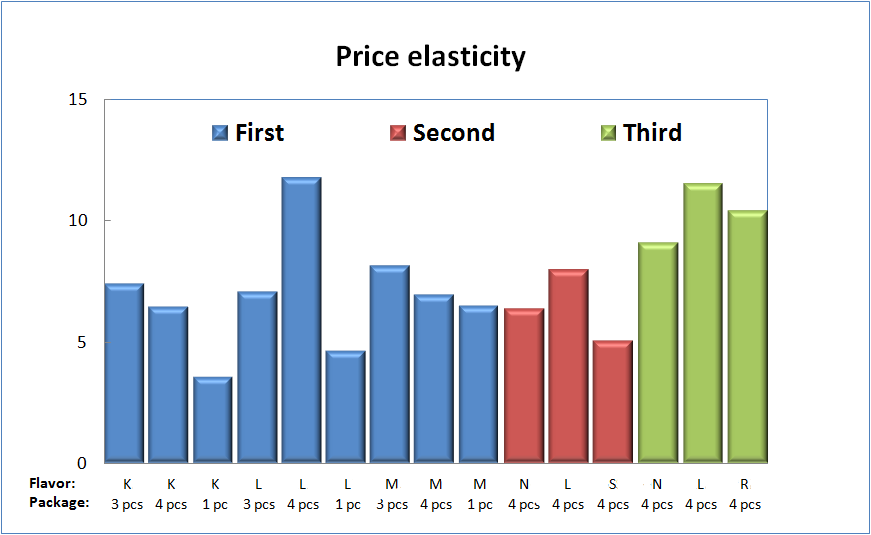
The stated elasticities are very high as the products are very similar and clear substitutes of each other. The highest elasticities are observed for the L flavor since it is offered by all brands. The low elasticities of 1 piece packs reflect no size alternatives among the competing brands. The Second brand is clearly the most resistant against price moves of the competition.
An example of uncorrected (stated) elasticities for selected Czech beers is in the picture below. The sample of 1338 respondents was large enough for the results to be reasonably reliable. Glass 0.5 l bottles and 1.5 l PET bottles have been the objects in the study.
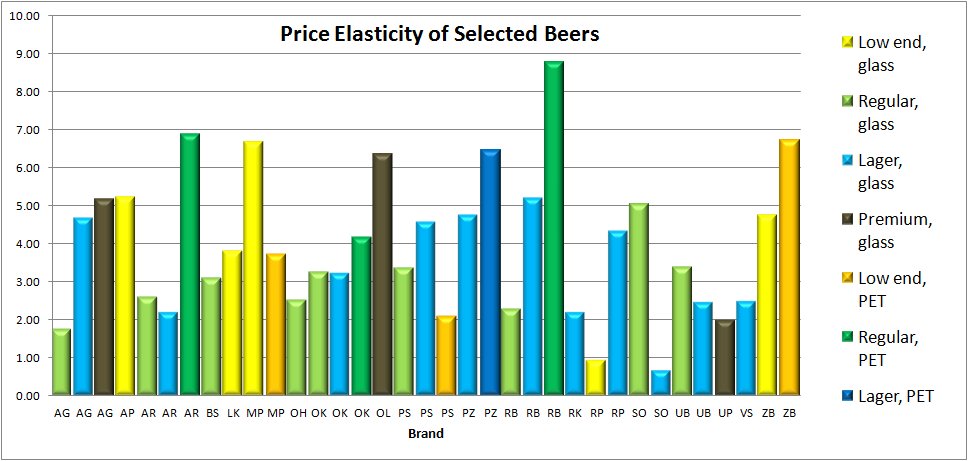
In general, PET bottled beers show the highest price elasticities. When made more expensive, they can be easily substituted with glass bottled beer of the same brand and, perceptually, of a better quality. The lowest elasticity is observed for the local lager SO favored by the local patriots. As a matter of fact, the local brands have in general medium elasticities. Elasticities of cheap glass-bottled low-end beers are, in general, higher than for regular beers.
A useful characteristic of a FMCG/CPG brand is loyalty expressed as probability of the next purchase of the same brand, i.e. uniqueness of the brand usage by an individual. As the conventional method of computing loyalty has been modified with price sensitivity to achieve a higher discrimination, the results are shown in this chapter.
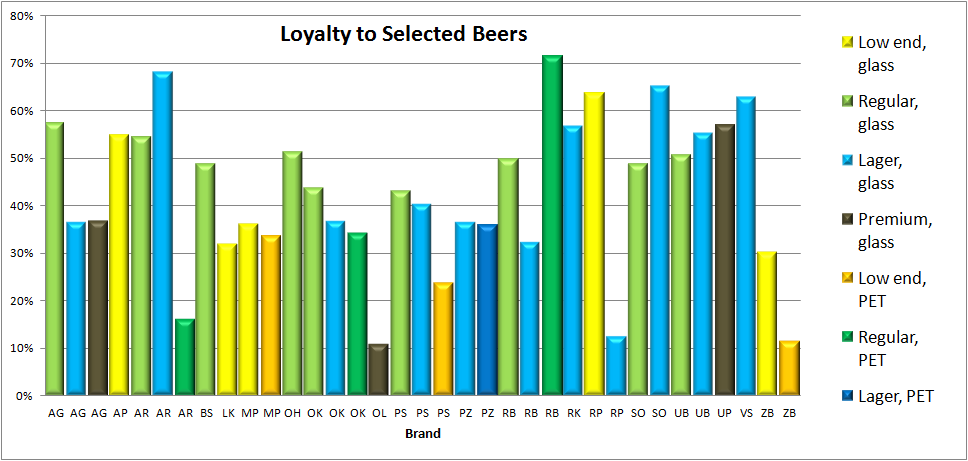
In general, loyalty to local beers is generally higher than loyalty to beers distributed nation-wide. The only exception is PET-bottled regular beer RB. Intuitively, one would expect loyalty to increase with decreasing price sensitivity. This is not always the case as the PET bottled brand RB clearly demonstrates.
Cross-elasticities relative to the glass-bottled low-end beer MP show that the direct competitors are another glass-bottled low-end beers and, not surprisingly, the same brand in PET bottle. As own elasticities are very high negative compared to the (positive) cross-elasticities, they have been replaced by arrows in the pictures.
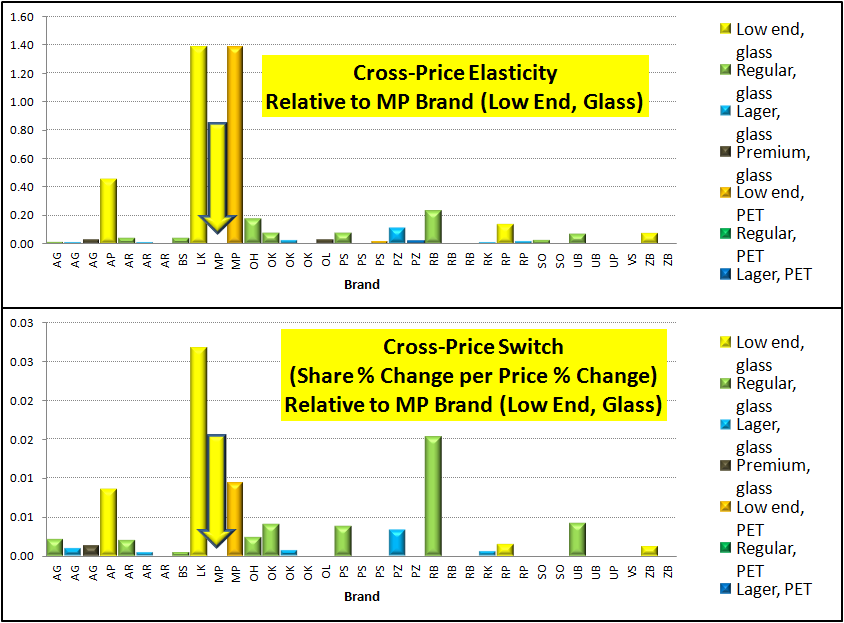
The estimated share switches are highest for similar brands AP, LK and BR rather than to the same brand in PET bottles.
A view relative to the same brand offered in PE bottles gives a slightly different picture. Rather than turning to the same brand in glass when PET price is increased, consumers would prefer PS brand in PET bottle more than the own brand in glass in the relative terms of cross-elasticity. However, as MP is stronger brand for its consumers than PS brand, the ratio of share switches would be reversed.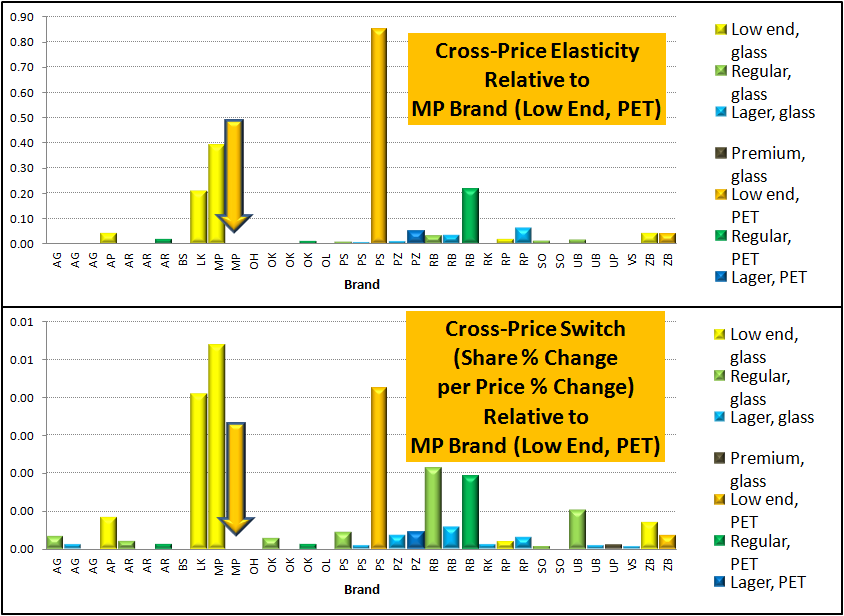
A similar analysis applied to the lager beer of the premium brand UP is shown on the picture below.
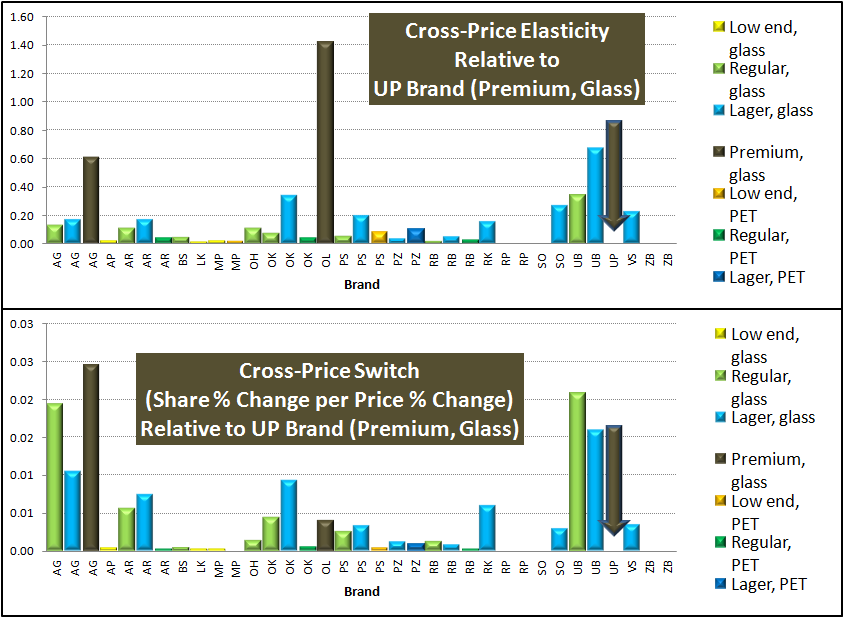
While cross-price elasticities clearly show the brands that compete directly irrespective of their share, the unused share potential of the brand OL is revealed when the switch shares are computed. Renowned lager beers show behavior resembling that of premium brands.